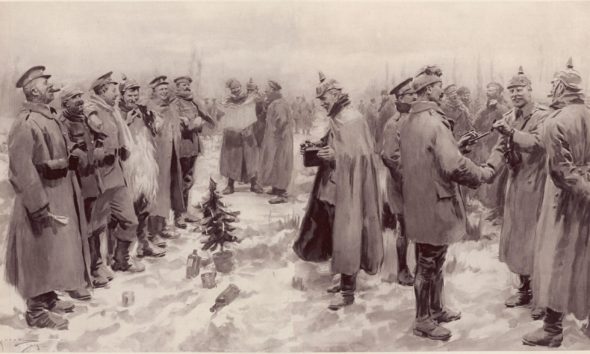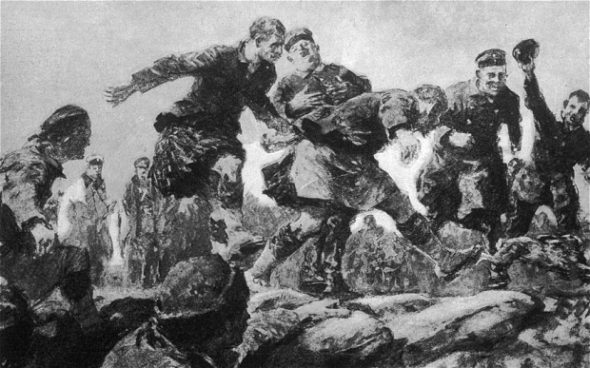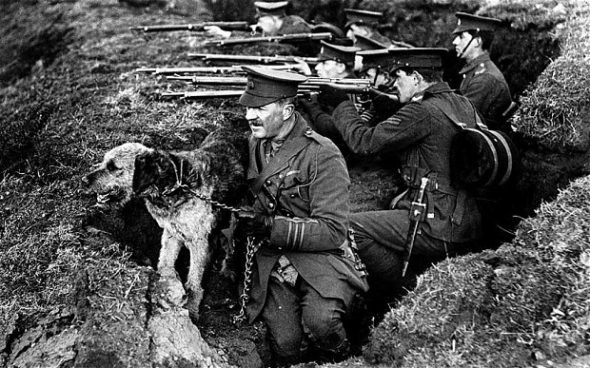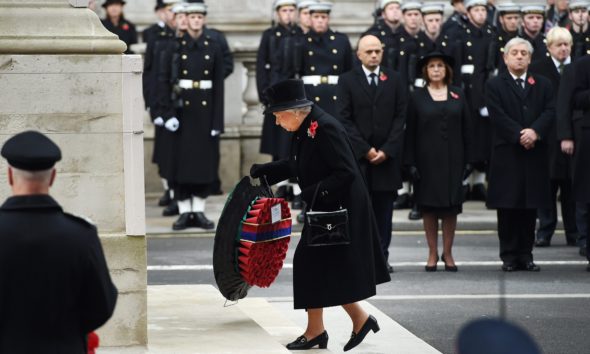redo Jump to...
print Print...
 WWI – Schools to recreate Christmas truce football matches to mark World War One centenary
WWI – Schools to recreate Christmas truce football matches to mark World War One centenary
Schools across Great Britain are to recreate the famous Christmas truce football matches to mark the centenary of the First World War.
The matches, one of the most recognizable moments of the Great War, saw German and allied soldiers cease fighting on Christmas Day 1914.
Now their memory is to be revived as part of the Football Remembers project, which has been established by the British Council, the Premier League, Football League and English football’s governing body, The Football Association (FA).
 The project aims to help children learn about the truce, including the impromptu games of football that took place along the Western Front on Christmas Day 1914.
The project aims to help children learn about the truce, including the impromptu games of football that took place along the Western Front on Christmas Day 1914.
Those schools taking part and holding special matches, which will all take place in December, are being asked to mark the event by getting both teams to pose together for a photo and tweeting the picture using the hashtag #FootballRemembers.
The photos will be uploaded to a footballremembers website as a permanent online tribute to those soldiers who laid down their arms during the unofficial ceasefires.
The Duke of Cambridge, who is president of the FA, said: “We all grew up with the story of soldiers from both sides putting down their arms on Christmas Day, and it remains wholly relevant today as a message of hope over adversity, even in the bleakest of times.”
… Earlier this year, research released by the British Council found the Christmas Truce was one of the most recognised moments of the First World War – with more than two thirds of UK adults aware of the historic football matches.
WWI – Dogs of war: the unsung heroes of the trenches
In 1918, while serving on the Western Front with the Sherwood Foresters, Jack the Airedale saved an entire battalion.
The detachment of the Foresters were at an advanced post, surrounded by the German Army, all communications cut off and with the supply lines four miles behind them. Their only hope rested on Jack’s fragile shoulders. A message requesting urgent help was tied to his collar, and he was dispatched to try and make it to headquarters.

Captain Richardson in the trenches with his dog in 1914
The Great War messenger dogs were taught to seek out cover amid the carnage of No Man’s Land. As Jack darted between craters, he was struck twice by German bullets. He made it, but only at a crawl, covered in blood and died of his injuries on arrival. The message, however, got through.
Last month, Jack’s name was honored at the Collars and Coats Gala Ball hosted by the Battersea Dogs Home celebrating the roll of their animals in the trenches.
Lieutenant Colonel E.H Richardson, a police and military dog trainer, first wrote to the home in 1914 to request a batch of recruits for a specialist canine brigade training center that he wished to establish in Kent, England. The home, which was established in 1860, had already received an influx of dogs following the outbreak of war as people struggled to feed themselves, let alone their dogs. …
Lt Col Richardson was after lurchers, known as the poacher’s dog and perfectly suited to war, as well as airedales, collies, sheepdogs and whippets. By 1915 his training center was up and running.
Each dog was required to undergo six weeks of intensive training, leaping over obstacle courses, shell holes and through torn barbed wire. Initially, Richardson planned for his dogs only to search out injured soldiers on the battlefield, but it soon became apparent they made excellent messengers as well.
“The skill, courage and tenacity of these dogs has been amazing,” he said. “During heavy barrages, when all other communications have been cut, the messenger dogs have made their way, and in many cases have brought messages of vital importance.”
Great danes, boarhounds and mastiffs were also considered ideal watchdogs. The animals were posted on sentry duty near the top of the trench, next to its master’s gun barrel, to let the soldier know quietly if anyone attempted to approach.
A report, from a newspaper in 1916, describes the temperament required from such an animal. “A watchdog never barks; at the most he will use a low growl to indicate the presence or approach of a hostile force. More often than not the mere pricking of the ears or the attitude of expectancy is sufficient to put his master on his guard.”
Such was the danger of their posting that many of the animals were killed. The Dundee Courier, in November 1916, detailed the fate of Marquis, a dispatch [messenger] dog with the French army. “His soldier comrades buried him and raised a monument over his grave. He had been sent out with a message at a time when owing to the intensity of German fire, it was unsafe to send a human messenger. Marquis received a bullet wound and fell, but managed to crawl back with the message undelivered, letting it drop out of his mouth, stained with blood at his masters feet.”
Sometimes, however, the dog’s main role was simply to raise morale. To chase away the vast lumbering rats that surfed through the mud; or act as man’s best friend in the most inhumane of environments. Some 20,0000 dogs served alongside British troops in the First World War.
Queen leads Remembrance Day tributes at the Cenotaph
Remembrance Sunday services were held across the United Kingdom to honor the country’s fallen troops on Sunday, November 9th.
In London, the Queen led a ceremony at Whitehall’s Cenotaph where she laid a wreath in memory of members of the armed forces killed while serving the nation.

Britain’s Queen Elizabeth II lays a wreath at the Cenotaph on Remembrance Sunday in London, November 9, 2014.
The event is the focal point of the country’s Remembrance Sunday ceremonies and saw other senior royals and political leaders also leave floral tributes at the memorial.
A two-minute silence at the heart of the service was marked at the beginning and end by the King’s Troop Royal Horse Artillery firing one round from one of their 13-pounder First World War guns from Horse Guards Parade.
Prime Minister David Cameron said this year’s Remembrance Sunday was “particularly poignant” as 2014 marked the 100th anniversary of the start of the First World War, the 70th anniversary of the D-Day landings and the end of Britain’s conflict in Afghanistan.
Security around the royal family and senior politicians attending today’s events was at its tightest since 2001 after police and the intelligence services claimed to have foiled a plot by Islamists to mount a terrorist attack.
A service was also held at the National Memorial Arboretum in Staffordshire, before wreaths were laid at the stone armed forces memorial.
As dusk fell, images of falling poppies are to be projected onto Big Ben – as part of commemorations of the centenary of the conflict.
A section of the ceramic poppy field at the Tower of London – which will have 888,246 ceramic poppies installed by Armistice Day (Nov. 11), one for each British and colonial death during the conflict – will now remain on show until the end of the month.
(The news briefs above are from wire reports and staff reports posted at London’s Daily Telegraph on Nov. 5, Oct. 29 and Nov.10.)
Questions
1. For GREAT BRITAIN, give the following information:
a) capital
b) location/the countries that share its borders:
c) the religious breakdown of the population:
d) the type of government:
e) the chief of state (and head of government if different) [If monarch or dictator, since what date has he/she ruled? – include name of heir apparent for monarch]:
f) the population:
NOTE: Before answering the questions below, read the info under “Background” and watch the videos under “Resources.”
2. For GREAT BRITAIN – WWI CHRISTMAS TRUCE:
a) list the who, what, where and when of the news item
b) What is the purpose of the “Football Remembers” project in Great Britain?
c) Where was the Western Front?
d) Ask a grandparent: What do you know about the Christmas Day true of 1914? What do you remember learning in school about this event?
3. For GREAT BRITAIN – WWI DOGS:
a) list the who, what, where and when of the news item
b) For what purpose did officers like Col. Richardson plan to use dogs during WWI?
c) In what other capacities were dogs utilized? Why was this so?
d) What was “No Mans Land” in WWI?
4. For GREAT BRITAIN – QUEEN COMMEMORATES WWI ON REMEMBRANCE DAY:
a) list the who, what, where and when of the news item
b) What is the main focus of Great Britain’s Remembrance Sunday ceremonies?
c) How does Britain’s Remembrance Day on Nov. 11 differ from our Veterans Day on Nov. 11?
d) What is Britain’s Cenotaph?
Background
WWI – Christmas Truce of 1914: The Christmas truce was a series of widespread, unofficial ceasefires that took place along the Western Front around Christmas 1914, during World War I. Through the week leading up to Christmas, parties of German and British soldiers began to exchange seasonal greetings and songs between their trenches; on occasion, the tension was reduced to the point that individuals would walk across to talk to their opposite numbers bearing gifts. On Christmas Eve and Christmas Day, many soldiers from both sides—as well as, to a lesser degree, from French units—independently ventured into “no man’s land”, where they mingled, exchanging food and souvenirs. As well as joint burial ceremonies, several meetings ended in carol-singing. Troops from both sides were also friendly enough to play games of football with one another. (from wikipedia)
Read more at: christmastruce.co.uk/article.html
About the Western Front:
American troops did not enter WWI until 1917:
During World War I, the first 14,000 U.S. infantry troops land in France at the port of Saint Nazaire in June 1917. The landing site had been kept secret because of the menace of German submarines, but by the time the Americans had lined up to take their first salute on French soil, an enthusiastic crowd had gathered to welcome them. However, the “Doughboys,” as the British referred to the green American troops, were untrained, ill-equipped, and far from ready for the difficulties of fighting along the Western Front.
One of U.S. General John J. Pershing’s first duties as commander of the American Expeditionary Force was to set up training camps in France and establish communication and supply networks. Four months later, on October 21, the first Americans entered combat when units from the U.S. Army’s First Division were assigned to Allied trenches in the Luneville sector near Nancy, France. Each American unit was attached to a corresponding French unit. Two days later, Corporal Robert Bralet of the Sixth Artillery became the first U.S. soldier to fire a shot in the war when he discharged a French 75mm gun into a German trench a half mile away. On November 2, Corporal James Gresham and privates Thomas Enright and Merle Hay of the 16th Infantry became the first American soldiers to die when Germans raided their trenches near Bathelemont, France.
After four years of bloody stalemate along the Western Front, the entrance of America’s well-supplied forces into the conflict was a major turning point in the war. When the war finally ended on November 11, 1918, more than two million American soldiers had served on the battlefields of Western Europe, and more than 50,000 of these men had lost their lives. (from history.com)
Resources
1910s war dogs sending messages in WWI trenches:
From the first light of dawn to the fall of night, thousands of people come each day to honour the First World War dead at the sea of red ceramic poppies at the Tower of London. Watch a time-lapse video from dawn to dusk:
Ahead of the centenary of the outbreak of World War One, London’s The Telegraph counts the cost of one of the bloodiest wars in history:
Daily “Answers” emails are provided for Daily News Articles, Tuesday’s World Events and Friday’s News Quiz.



